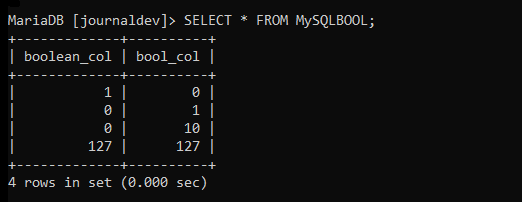
Still, data types are often the first line of defense against invalid data.įor many cases, the general types provided by MySQL are appropriate for the kinds of data you'll be storing. Other database tools, like constraints also have a role to play in defining correctness. Getting started with MySQL data typesĪs you get started with types, it's important to remember that types alone are not always a complete solution to data validation, but a component. We'll cover the most common of these in more depth throughout this guide. MySQL supports a reasonable range of data types suitable for various types of simple and complex data. What are the data types in MySQL?īefore going into detail, let's take a broad view of what data types MySQL provides.
#Boolean mysql data type how to
In this guide, we will discuss the most common data types available in MySQL, the different input and output formats they use, and how to configure various fields to meet your applications' needs. MySQL includes a wide range of data types that are used to label and validate that values conform to appropriate types. While it is possible to define custom requirements, data types provide the basic building blocks that allow MySQL to validate input and work with the data using appropriate operations. Values must adhere to the requirements that they outline in order to be accepted by MySQL. This is done by prescribing the columns that these structures contain along with their data type and any constraints.ĭata types specify a general pattern for the data they accept and store. One of the primary features of relational databases in general is the ability to define schemas or table structures that exactly specify the format of the data they will contain. The United States' most popular databases by state going into 2022.Traditional databases vs serverless databases.Introduction to common serverless challenges.Top 13 serverless computing and database providers.Introduction to database backup considerations.How microservices and monoliths impact the database.Syncing development databases between team members.Troubleshooting database outages and connection issues.What is connection pooling and how does it work?.Top 8 TypeScript ORMs, query builders, & database libraries: evaluating type safety.Top 11 Node.js ORMs, query builders & database libraries in 2022.Introduction to MongoDB Aggregation Framework.Introduction to MongoDB database tools & utilities.Working with dates and times in MongoDB.Introduction to MongoDB connection URIs.How to query and filter documents in MongoDB.How to manage databases and collections in MongoDB.How to manage authorization and privileges in MongoDB.How to manage users and authentication in MongoDB.Introduction to provisioning MongoDB Atlas.How to export database and table schemas in SQLite.

#Boolean mysql data type update
How to update existing data with SQLite.How to perform basic queries with `SELECT` with SQLite.Inserting and deleting data with SQLite.Creating and deleting databases and tables with SQLite.An introduction to MySQL column and table constraints.How to create and delete databases and tables in MySQL.An introduction to PostgreSQL column and table constraints.An introduction to PostgreSQL data types.How to create and delete databases and tables in PostgreSQL.How to configure a PostgreSQL database on RDS.Comparing relational and document databases.Glossary of common database terminology.Comparing database types: how database types evolved to meet different needs.


 0 kommentar(er)
0 kommentar(er)
